 |
|||
Wallace Allan Wood Wallace Wood wurde am 17. Juni 1927 in Menahga, Minnesota, USA geboren und besuchte nach dem Kriegsdienst 1947 die Minneapolis School of Art, bevor er ein Jahr später nach New York zog und für ein Semester auf die Burne Hogarth School of Visual Arts wechselte. Er war ein vielseitiger, engagierter Comic-Autor, Zeichner und unabhängiger Verleger, der vor allem durch seine Arbeiten in EC Comics Titeln wie Weird Science und Weird Fantasy, sowie dem MAD Magazine bekannt wurde. Statt Wallace Wood wir oft auch sein Spitzname Wally Wood verwendet, obwohl er persönlich nicht mochte, "Wally" genannt zu werden und signierte einige seiner Arbeiten eher mit dem Kürzel "Woody". (1) Sein künstlerisches Schaffen war enorm, doch persönliche Krisen und zerstörerische Abhängigkeiten ließen - auf eher tragische Weise - seinen Stern vorzeitig verglühen. Er nahm sich am 2. November 1981 selbst das Leben. Er wurde nur 54 Jahre alt. Er begann als Tuschezeichner für "Terry and the Pirates" von George Wunder, sowie für den Titel "The Spirit" von Will Eisner, dessen Assistent er wurde. 1949 produzierte er seine ersten Geschichten für Serien, die bei Avon ("Captain Steve Savage", "Captain Science",…) und Fox Features Syndicate ("My Secret Life", "My confession", "My Love Story"…,) herausgegeben wurden. Anfang der 1950er Jahre wechselte er zu EC Comics, wo er für Serien wie "Frontline Combat", "Haunt of Fear", "Weird Science", "Weird Fantasy" und dem MAD Magazin zeichnete. MAD-Chef Harvey Kurtzman selbst holte ihn für "das vernünftigste Magazin der Welt". Dort wurde er zum bestbezahlten Künstler, der rund 200 Dollar pro Seite verdiente - Marvel Comic zahlte zu dieser Zeit 20 Dollar pro Bleistiftseite und 15 Dollar für die Tusche-Arbeiten pro Seite. Zwischen 1957 und 1967 illustrierte er für das Magazin Galaxy. Er arbeitete zudem für die Werbeindustrie, für Marvel und DC Comic und kreierte unter "anderem T.H.U.N.D.E.R. Agents" für Tower Comics. Im Jahr 1969 veröffentlichten Wallace Wood und sein Team mit "Heroes, Inc. Presents Cannon", einen der ersten unabhängigen Comic. Cannon entstand in Zusammenarbeit mit Steve Ditko und handelte von einem CIA-Agenten, der durch eine Gehirnwäsche zu einer emotionslosen Tötungsmaschine wurde. Wallace Wood arbeitete für Titel wie "Prince Valiant", "Flash Gordon" und "Tarzan". Von 1966 bis 1969 gab er das halbamateurhafte Magazin Witzend heraus, wofür Wood seine ersten erotischen Geschichten mit hübschen Mädchen zeichnete. Die bezaubernde Sally Forth präsentierte ihren üppigen Busen und prallen Hintern ab Juni 1968 den Lesern der Military News, und ab 1971 der Overseas Weekly; der Zeitung für amerikanische Soldaten in Europa. "Die barbusige Version von Bob Hope" war dafür zuständig, die Moral der amerikanischen Soldaten zu unterstützen, und es fehlt ihr keineswegs an Argumenten, um die Truppen von Onkel Sam aufzuheitern. Ihr Name ist ein Wortspiel: "to sally forth" bedeutet, ein Militärlager zu verlassen oder anzugreifen. (2) Diese Strips waren jedoch nicht explizit oder pornografisch. Die "Sally Forth"-Hardcore-Variante zeichnete Wood Jahre später für die Hefte Gang Bang. Mit Unterstützung durch die Zeichner Nick Cuti, Paul Kirchner und Larry Hama wurde die Serie "Sally Forth" in der Overseas Weekly bis zum 22. April 1974 fortgesetzt. In den Jahren 1993 bis 1995 formatierte der Autor und Herausgeber Bill Pearson, Woods Freund und Mitarbeiter des Wood Studios, die "Sally Forth"-Strips zu einer Reihe von Comics um, die von Eros Comix, einem Imprint von Fantagraphics Books, veröffentlicht wurden. Im Jahr 1998 gab Pearson die gesamte Serie in einem einzigen 160-seitigen Band heraus, der ebenfalls bei Fantagraphics erschien. Der Sammelband Eros #38 Naughty Knotty Woody wirbt mit dem Zusatz "die komplette Sammlung von Wallace Woods erotischem Werk", was nicht stimmt. Die Sammlung ist eher eine lose Reihung von Kurzgeschichten wie "Far-Out Fables", "Pipsqueak Papers", "Malice in Wonderland", "The Wizard of Ooz", sowie eine Menge an Scribbles und Skizzen - jedoch keiner Zeichnung mit "Sally Forth". Eros Comics veröffentlichte zudem einige Comichefte, wie die 8-teilige Serie "Sally Forth" (1993-1995) (mit sieben schlechten Titelbildern von diversen Zeichnern und einem guten (das 8te) von Adam Hughes), sowie den One-shots "Horny Toads" (1993), "Pipsqueak Papers (1993) und "Malice in Wonderland" (1993). Auch die Serie "Cannon" schaffte es ins Eros Comix Comicheft-Programm. "Sally versucht auf ihre Art und Weise - nämlich mit viel Sex und Naivität beziehungsweise Dummheit; eine Mischung, die kaum zu schlagen ist - das Militär zu boykottieren. Ihre Schwester Libby kommt mit ihren Freundinnen dazu, und schließlich wird Sally … auf den Mond geschickt, wo sie ihren Freund Snorky, ein liebes kleines Marsmännchen, wiedertrifft. Die ganze Story dient dabei vorwiegend dem Zweck, die voluminösen Brüste und nackten Körper - nicht nur von Sally, sondern auch von anderen Mitgespielinnen - zu präsentieren." (3) Zu seinen letzten Veröffentlichungen zählen zwei Ausgaben mit dem Titel Gang Bang (Nuance, Inc., 1980, 1981, 1983) (eine dritte Ausgabe wurde posthum veröffentlicht (6)), das explizite Porno-Geschichten mit seiner eigenen Figur "Sally Forth" und einer Auswahl an Parodien enthält. Dazu gehören Walt Disneys "Schneewittchen und die sieben Zwerge" ("So White and the Six Dorks"), Milton Caniffs "Terry and The Pirates" ("Perry and the Privates"), Hal Fosters "Prince Valiant" ("Prince Violate"), DCs "Superman" und "Wonder Woman" ("Stuporman Meets Blunder Woman"), Alex Raymonds "Flash Gordon" ("Flasher Gordon") und Edgar Rice Burroughs' "Tarzan" ("Starzan").(4) Die Geschichte Malice in Wonderland erschien 1976 in der ersten Ausgabe von The National Screws und war eine nicht jugendfreie Parodie der klassischen Geschichte von Lewis Carroll. In einer unbequemen Szene wird eine weibliche Maus (mit menschlichen Brüsten und Geschlechtsteil) abfällig misshandelt und vergewaltigt. Offenbar trieb Wood damit seine Dämonen aus, nachdem er seine zweite Scheidung in weniger als fünf Jahren durchgemacht hatte. (6) Auch im Eros-Sammelband sind satirisch frauenfeindliche Anspielungen zu finden, die die holde Weiblichkeit nicht gerade in einem freundlichen Licht beleuchtet; zum Beispiel in mehreren Skizzen von nackten Frauen, die lasziv in einer Bärenfalle liegen. 1986 erschien posthum bei Eclipse Comics (USA) die 5-teilige Heftserie "World of Wood" mit kurzweiligen Fantasy und Science Fiction-Geschichten, nur leicht mit erotischen Elementen gewürzt. Dabei wurden Auszüge aus diversen Magazin-Veröffentlichungen aus den 1960 und 1970er Jahren zusammengestellt; Titel wie "Vampirella", "Cannon", "Blazing Combat", "Eerie", "Creepy",… Der Sammelband The Erotic Art of Wallace Wood (2019, Fantagraphics) fasst etliche erotische Comic- und Cartoon-Material (auch von diversen Screw-Titeln) von Wood zusammen. Seine berüchtigte Zeichnung Disneyland Memorial Orgy ist ein anzügliches Wimmelbild mit diversen Disney-Charakteren. Es erschien erstmals im Mai 1967 als Centerfold im Satiremagazin The Realist und hat seither weite Verbreitung als Poster gefunden. Es stellt dar, wie die Comic-Figuren des Walt-Disney-Konzerns den Tod des im Dezember 1966 verstorbenen Firmengründers Walt Disney mit einer ausschweifenden Orgie in Disneyland feiern. Bemerkenswert an dieser Zeichnung ist die gekonnt stilechte Umsetzung. Die abgebildeten Figuren könnten auch von diversen Disney-Stammzeichnern illustriert worden sein, so gut ist diese Parodie. Und deshalb funktioniert sie so gut. Wallace Wood, der auf eine ebenso vielfältige wie dichte Karriere zurückblicken konnte, hatte einen sehr feinen Strich, der dem der europäischen Comics ähnelte. Sein künstlerisches Können war ohne Tadel und breit aufgestellt. Ob Superhelden, Science Fiction, Monster und Barbaren, Cartoons und Erotisches. Wood ist legendär für seine stilsicheren Zeichnungen in praktisch jedem Genre und war ein Meister in realistischen, wie auch in karikaturistischen Zeichenstilen. Wood gewann im Laufe seiner Karriere verschiedene Auszeichnungen, wie zum Beispiel den National Cartoonists Society Comic Book Division Awards (1957, 1959 und 1965) und den Alley Award (1965 und 1966). Zudem erhielt er posthume Ehrungen, wie die Aufnahme in die Jack Kirby Hall of Fame (1989) und in die Will Eisner Hall of Fame (1992). Gegen Ende seines Lebens erklärte ein verbittert klingender Wood laut einer Biografie: "Wenn ich alles noch einmal durchmachen müsste, würde ich mir die Hände abhacken". (5) In einem offenen und schmerzhaften Leitartikel musste Wood seinen Fans - am Ende seiner Karriere - gestehen, dass er nicht mehr in der Lage war zu arbeiten: "Die Gründe, warum ich aufhören musste, waren, dass ich keine Hilfe hatte und alles selbst machen musste, und dass ich Pech hatte... meine Nieren versagen, mein Blutdruck ist gestiegen, ich hatte drei kleine Schlaganfälle, so dass mein linkes Auge und meine linke Hand ziemlich nutzlos geworden sind." (6) Die letzten Jahre seines Lebens verbrachte Wood in Los Angeles. Als begeisterter Fan von Country- und Folk-Musik entwickelte er den Wunsch, selbst als Musiker aufzutreten. Er stellte (1978) ein selbstverlegtes Album mit dem Titel "Wally Wood Sings" zusammen, finanzierte es und trat bei Open-Mic-Nächten in örtlichen Kneipen auf. Doch zu dieser Zeit ging es Wallace Wood bereits sehr schlecht. Die Aussicht auf eine Dialyse und schließlich eine Nierentransplantation brachte ihn an den Rand seiner Kräfte. Am 3. November 1981 wurde seine Leiche mit einer selbst zugefügten Schusswunde gefunden. Der Tatzeitpunkt wurde einen Tag zurückdatiert. "Elfquest"-Schöpferin, Wendy Pini, war ein großer Fan von Woods "Wizard King". Der "Star Wars"-Schöpfer George Lucas nannte ihn "einen der größten Comiczeichner". Das Credo von Wallace Wood lautete: (frei übersetzt) Links: Quellen/Sources: Stand, 2023. Dank geht an Jan |
||||||||||||
Wallace Allan Wood Wallace Wood was born on 17 June 1927 in Menahga, Minnesota, USA and, after military service, attended the Minneapolis School of Art in 1947 before moving to New York a year later and transferring to the Burne Hogarth School of Visual Arts for a semester. He was a versatile, dedicated comics writer, cartoonist and independent publisher, best known for his work in EC Comics titles such as Weird Science and Weird Fantasy, as well as MAD Magazine. Instead of Wallace Wood, his nickname Wally Wood is often used, although he personally disliked being called "Wally" and signed some of his work with the abbreviation "Woody".(1) His artistic output was enormous, but personal crises and destructive addictions caused - in a rather tragic way - his career to burn out prematurely. He took his own life on 2. November 1981. He was only 54 years old. He began as an ink artist for "Terry and the Pirates" by George Wunder, as well as for the title "The Spirit" by Will Eisner, whose assistant he became. In 1949 he produced his first stories for series published by Avon ("Captain Steve Savage", "Captain Science",...) and Fox Features Syndicate ("My Secret Life", "My confession", "My Love Story"...,). In the early 1950s he moved to EC Comics, where he drew for series such as "Frontline Combat", "Haunt of Fear", "Weird Science", "Weird Fantasy" and the MAD magazine. MAD boss Harvey Kurtzman himself brought him in. There he became the highest paid artist, collecting around $200 per page - Marvel Comics at the time paid $20 per pencil page and $15 for the ink work per page. Between 1957 and 1967 he illustrated for Galaxy magazine. He also worked for the advertising industry, for Marvel and DC Comic and created T.H.U.N.D.E.R. Agents for Tower Comics, among other things. In 1969, Wallace Wood and his team published "Heroes, Inc. Presents Cannon", one of the first independent comics. Cannon was created in collaboration with Steve Ditko and was about a CIA agent who was brainwashed into becoming an emotionless killing machine. Wallace Wood also worked on titles such as "Prince Valiant", "Flash Gordon" and "Tarzan". From 1966 to 1969 he edited the semi-amateurish magazine Witzend, for which Wood drew his first erotic stories. The adorable Sally Forth presented her opulent bosom and bouncing ass to the readers of Military News from June 1968, and Overseas Weekly; the newspaper for American soldiers in Europe, from 1971. "The bare-chested version of Bob Hope" was responsible for bolstering the morale of American soldiers, and she is by no means lacking in arguments to cheer up Uncle Sam's troops. Her name is a play on words: "to sally forth" means to leave or attack a military camp. (2) However, these strips were not explicit or pornographic. Wood drew the "Sally Forth" hardcore variant years later for the Gang Bang magazines. With the support of cartoonists Nick Cuti, Paul Kirchner and Larry Hama, the "Sally Forth" series continued in the Overseas Weekly until 22 April 1974. From 1993 to 1995, writer and editor Bill Pearson, Wood's friend and collaborator at Wood Studio, reformatted the "Sally Forth" strips into a series of comics published by Eros Comix, an imprint of Fantagraphics Books. In 1998, Pearson issued the entire series in a single 160-page volume, also published by Fantagraphics. The anthology Eros #38 Naughty Knotty Woody advertises itself as "the complete collection of Wallace Wood's erotic work", which is not true. The collection is more a loose arrangement of short stories like "Far-Out Fables", "Pipsqueak Papers", "Malice in Wonderland", "The Wizard of Ooz", as well as a lot of scribbles and sketches - but no drawing with "Sally Forth". Eros Comics also published some comic books, such as the 8-part series "Sally Forth" (1993-1995) (with seven bad covers by various cartoonists and one good one (the 8th) by Adam Hughes), as well as the one-shots "Horny Toads" (1993), "Pipsqueak Papers (1993) and "Malice in Wonderland" (1993). The "Cannon" series also made it into the Eros Comix comic book programme. "Sally tries to boycott the military in her own way - namely with a lot of sex and naivety or stupidity; a mixture that is hard to beat. Her sister Libby joins in with her friends, and eventually Sally is sent … to the moon where she meets her friend Snorky, a lovely little Martian. The whole storyline is predominantly for the purpose of showing off the voluminous breasts and naked bodies - not only of Sally, but also of other fellow playmates." (3) His last publications include two issues entitled Gang Bang (Nuance, Inc., 1980, 1981, 1983) (a third issue was published after his death (6)), which contains explicit porno stories featuring his own character "Sally Forth" and a selection of parodies. These include Walt Disney's "Snow White and the Seven Dwarfs" ("So White and the Six Dorks"), Milton Caniff's "Terry and The Pirates" ("Perry and the Privates"), Hal Foster's "Prince Valiant" ("Prince Violate"), DC's "Superman" and "Wonder Woman" ("Stuporman Meets Blunder Woman"), Alex Raymond's "Flash Gordon" ("Flasher Gordon") and Edgar Rice Burroughs' "Tarzan" ("Starzan"). (4) The story Malice in Wonderland appeared in the first issue of The National Screws in 1976 and was an adult parody of Lewis Carroll's classic story. In one uncomfortable scene, a female mouse (with human breasts and genitalia) is abused in a derogatory way and raped. Apparently Wood was exorcising his demons with this after going through his second divorce in less than five years. (6) In 1986, Eclipse Comics (USA) posthumously published the 5-part series "World of Wood" with entertaining fantasy and science fiction stories, only slightly spiced with erotic elements. Excerpts from various magazine publications from the 1960s and 1970s were compiled; titles such as "Vampirella", "Cannon", "Blazing Combat", "Eerie", "Creepy",... The anthology The Erotic Art of Wallace Wood (2019, Fantagraphics) brings together quite a bit of Wood's erotic comic and cartoon material (including from various Screw titles). His infamous drawing Disneyland Memorial Orgy is a salacious collage - featuring various Disney characters. It first appeared as a centrefold in the satirical magazine The Realist in May 1967 and has since been widely distributed as a poster. It depicts the comic characters of the Walt Disney Company celebrating the death of the company's founder Walt Disney, who died in December 1966, with a debauched orgy at Disneyland. What is remarkable about this drawing is the skilfully authenticity of the style. The figures depicted could also have been illustrated by various Disney artists, that's how good this parody is. And that is why it works so well. Wallace Wood, who could look back on a career that was as varied as it was dense, had a very fine stroke that resembled that of European comics. His artistry was unimpeachable and broad-based. Whether superheroes, science fiction, monsters and barbarians, cartoons and erotica. Wood is legendary for his stylish drawings in practically every genre and was a master in realistic as well as caricaturistic drawing styles. Wood won several awards during his career, such as the National Cartoonists Society Comic Book Division Awards (1957, 1959 and 1965) and the Alley Award (1965 and 1966). He also received posthumous honours, such as induction into the Jack Kirby Hall of Fame (1989) and the Will Eisner Hall of Fame (1992). Towards the end of his life, a bitter-sounding Wood declared, according to a biography, "If I had to go through it all again, I'd cut off my hands." (5) In a frank and painful editorial, Wood had to confess to his fans - at the end of his career - that he was no longer able to work: "The reasons I had to quit were that I had no help and had to do everything myself, and I was unlucky.... my kidneys are failing, my blood pressure has gone up, I've had three small strokes, so my left eye and my left hand have become pretty useless." (6) Wood spent the last years of his life in Los Angeles. An avid fan of country and folk music, he developed a desire to perform as a musician himself. He put together (in 1978) a self-published album entitled "Wally Wood Sings", financed it and performed at open-mic nights in local pubs. But by this time Wallace Wood was in very poor health. The prospect of dialysis and eventually a kidney transplant brought him to the edge of his strength. On 3 November 1981, his body was found with a self-inflicted gunshot wound. The time of the crime was backdated one day. "Elfquest" creator, Wendy Pini, was a big fan of Wood's "Wizard King". "Star Wars" creator George Lucas called him "one of the greatest comic book artists". Wallace Wood's credo was: |
||||||||||||
 |
||||||||||||
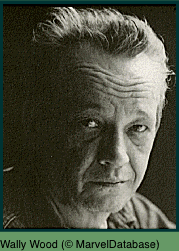 |
||||||||||||
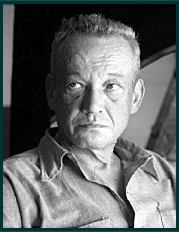 |
||||||||||||
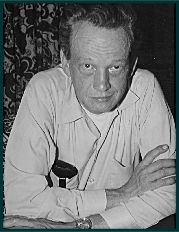 |
||||||||||||
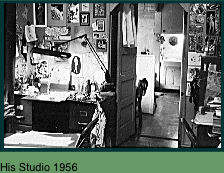 |
||||||||||||
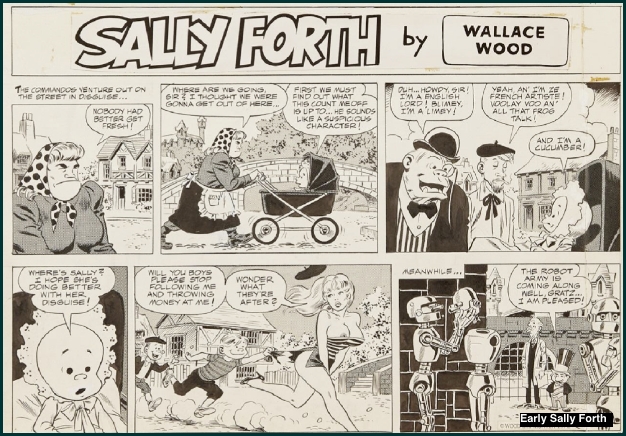 |
||||||||||||
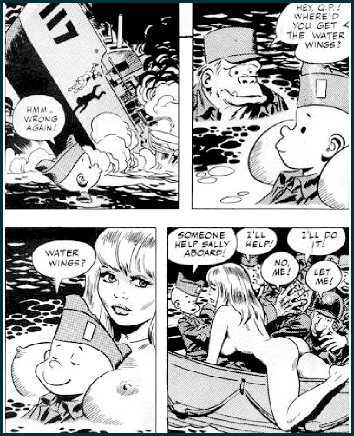 |
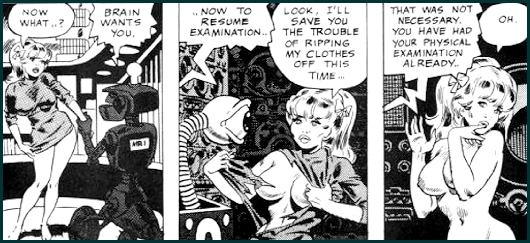 |
|||
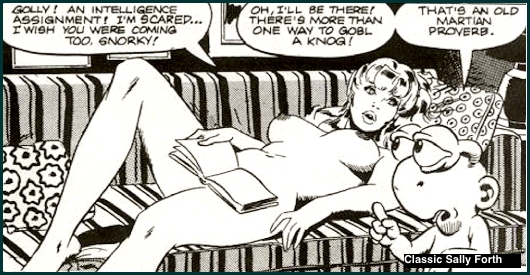 |
||||
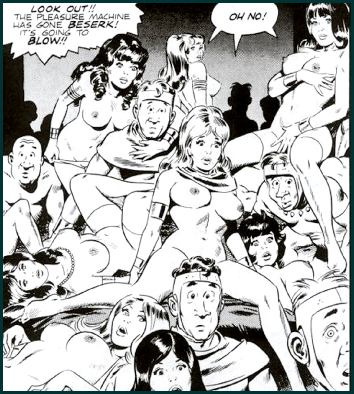 |
||||
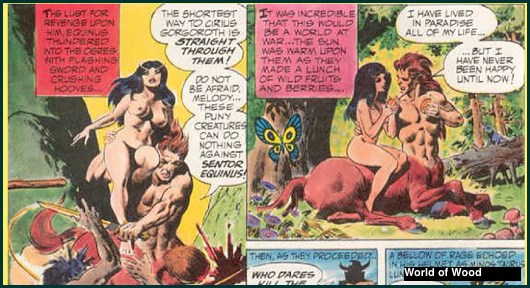 |
||||
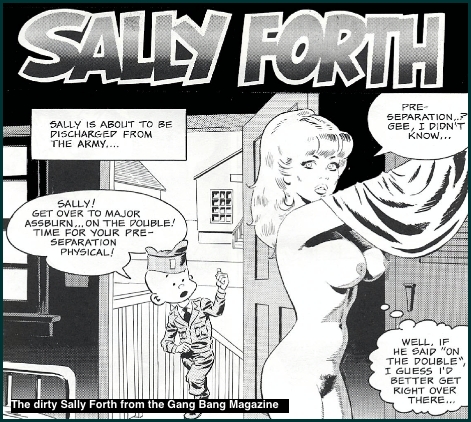 |
 |
|||
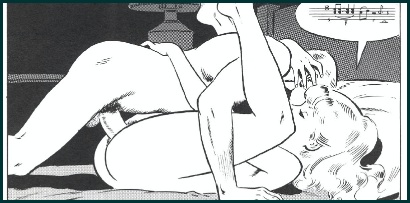 |
||||
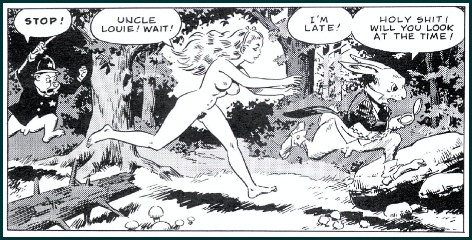 |
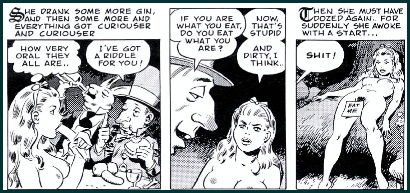 |
||||
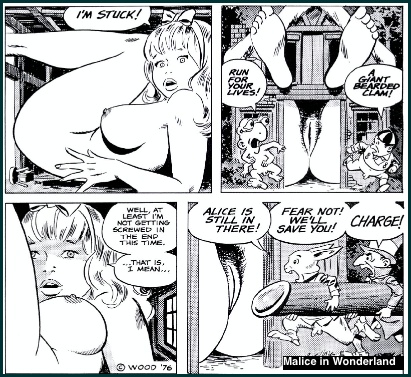 |
|||||
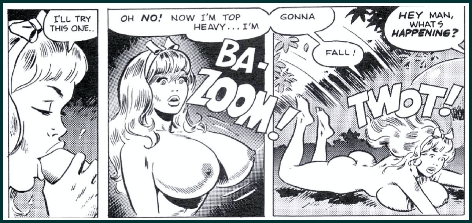 |
|||||
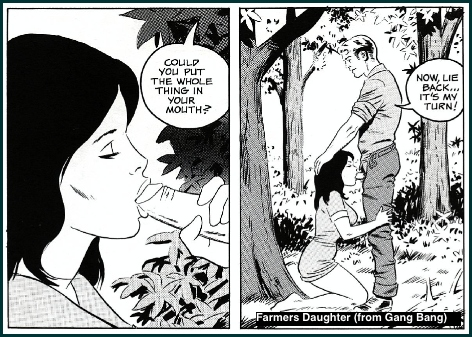 |
|||||
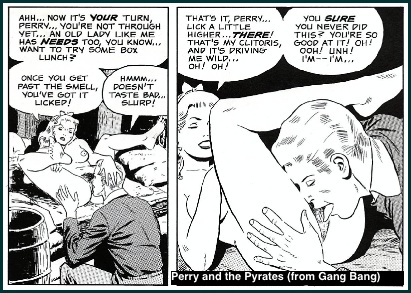 |
|||||
 |
||
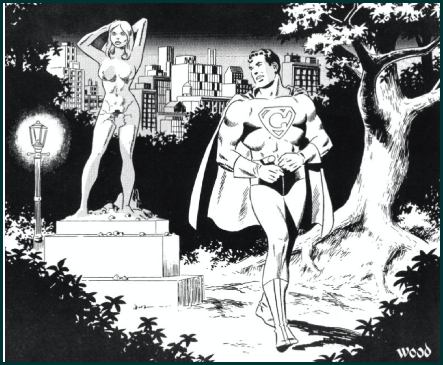 |
||||
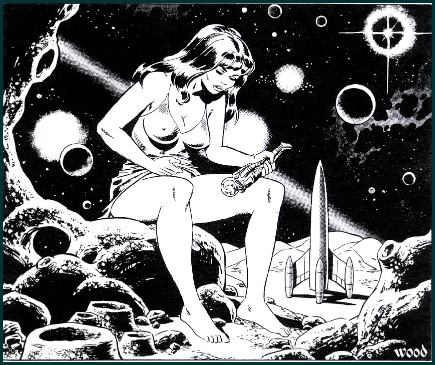 |
||||
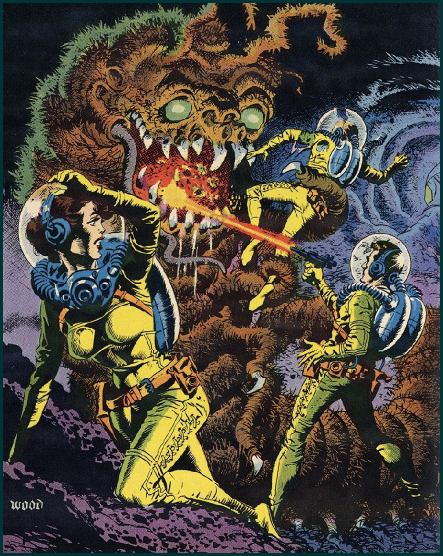 |
||||
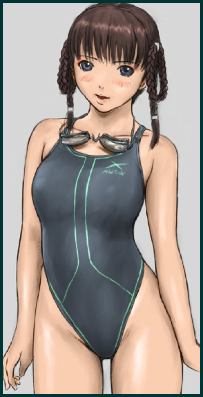 |
||||